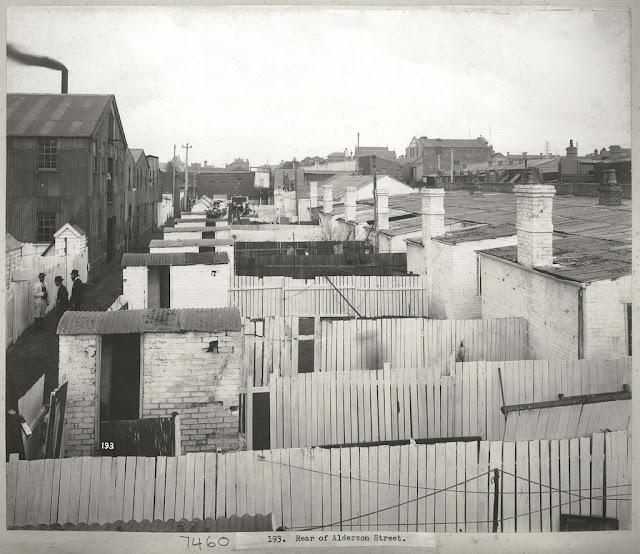Some bygone buildings . . .
**********
Fort Macquarie 1870
Fort Macquarie was built on the end of Bennelong Point, where the Sydney Opera House now stands. Completed by convict labour in 1821 using stone from the Domain, the fort had 15 guns and housed a small garrison. The powder magazine beneath the tower was capable of storing 350 barrels of gunpowder. The fort was demolished in 1901 to make way for the tramway sheds that occupied the site until the construction of the Opera House.
**********
Free Public Library, corner of Bent & Macquarie Sts, Sydney, 1877
In 1845 the Australian Subscription Library moved to the corner of Macquarie and Bent Streets. It was taken over by the Government in 1869 and renamed the Free Public Library of NSW. It was demolished for the Premier Wing of the State Office Block (1967). This in turn was demolished for the Aurora Place/Macquarie Apartments complex, which won both the Wilkinson and Sulman architecture awards in 2004.
**********
Royal Arcade, Sydney, 1892
The Royal Arcade ran from George Street near the markets, through to Pitt Street, near the School of Arts. Over 90 metres long, it was well lit, with a lofty celestory and gas lamps. There were 31 shops on the ground floor, 36 offices on the first floor and a photographic studio above them at the George Street end. Of Sydney’s five Victorian arcades, only the Strand survived twentieth century development, the Royal disappearing beneath the Hilton Hotel in the mid 1970s.
**********
Volunteer Hotel, Pitt Street, Sydney, c 1870
This building had been on the south-west corner of Pitt and Park Streets since the 1840s as a butcher’s shop. By the 1850s it had become the Butchers Arms Hotel, which changed its name to the Volunteer Hotel around 1862. It was demolished in 1882, to be replaced by the Equitable Building. This became Park House, one of several buildings in the block now owned by the Sydney City Council and planned for demolition to create an open square opposite the Town Hall.
**********
Weatherboard Buildings, Market Street, Cnr Clarence Street, Sydney, 1875
This photograph accompanied a scathing Government report into the city’s sewerage system. Of these dwellings, it said, ‘Anyone who may be curious to know how long Colonial timber will last, until, by the combined action of the elements, white ants, and other sources of destruction, it becomes triturated into powder, can satisfy their curiosity by ascertaining the date on which these houses were constructed. The corner house is occupied and used as a butcher's shop; it is a filthy stinking place...’
**********
46-52 Arthur Street, North Sydney, the street having been resumed and all buildings demolished for the Warringah Freeway in the 1960s.
Points to note:
- The wire clotheslines, kept low enough for mum to hang out the washing and then being propped higher with wooden poles.
- The outside toilets, accessible to the sanitary workers via rear lanes. These days the lanes in the inner suburbs serve no further purpose and attract rubbish dumping, vermin and drug activity. Councils therefore frequently sell the rear lane portions to the allotments in front of them. Back in 1926 a toilet was often referred to by the slang name “dunny”.
According to Wikipedia:
The dunny is an Australian expression for an outside toilet or outhouse. The person who appeared weekly to empty the pan beneath the seat was known as the dunnyman. The word derives from the British dialect word dunnekin, meaning dung-house. It is now an informal word used for any lavatory and is most often used referring to drop or pit lavatories in the Australian bush, which are also called thunderboxes.
**********
Wynard Station, Sydney, 1930, pouring the roof slab
**********
75 Blue Street, North Sydney 1926
**********
35-47 Junction Street, North Sydney 1926 –now part of the Pacific Highway
**********
Rear of Alderson Street, Sydney (NSW), 1900
From a series of images showing the areas in Sydney affected by the outbreak of Bubonic Plague in 1900. Taken by Mr. John Degotardi, Jr., photographer from the Department of Public Works, the images depict the state of the houses and 'slum' buildings at the time of the outbreak and the cleansing and disinfecting operations which followed.
Note that it shows the rear yards, toilets and “dunny lane” mentioned earlier. In this case the photograph also shows another aspect of the outside toilet system: that the pans were accessible from the lane without needing to enter the premises. The pans were removed by means of a small door at the rear of the toilet which enabled the pan to be removed without having to eb[












This comment has been removed by a blog administrator.
ReplyDelete